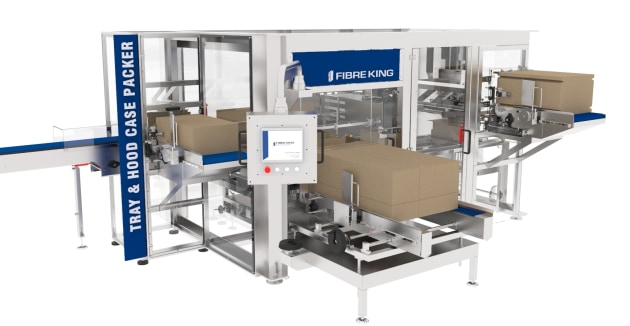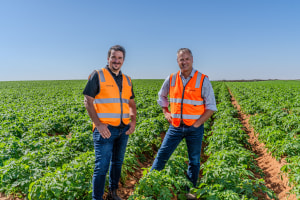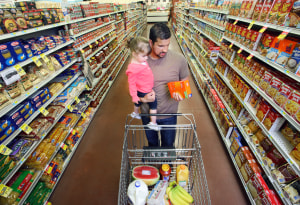Fibre King has developed a turnkey end of line packaging system for Nestle, including a cobot palletiser, for a range of Nescafe stand-up coffee pouches packed in tray and hood cases. The line provides for quick changeovers and flexibility to swap between the customer's product lines and various case configurations.
Fibre King’s solution includes customised, integrated case packing, robotic palletising, and related case and pallet conveyors delivered to project specifications.
It also features Fibre King’s exclusive Pallet Pattern Building Software, resulting in reduced downtime and servicing costs.
Tray & hood casepacker
The Fibre King tray and hood casepacker has been designed as a compact all-in-one machine that automatically collates and loads the products into an HSC case drawn from a magazine, then lids the product and glue seals.

“The result of this automation process is consistently neat, user-friendly packaging for stockists and consumers,” said Dale Sinclair, project manager at Fibre King.
The products are separated to create a gap using a twin infeed belt. The products are then conveyed into a dual servo cleated belt.
Each section of the belt can hold up to three packs depending on the product, and the belt is servo driven to accurately position the belt to index the products into the pockets.
Once the required row count is in the cleated belt, this section of the belt is driven to the side indexing station, while a side push assembly pushes the products into the loader area.
This is repeated forming two rows of product, and as the second row is being side indexed, a partition is inserted between the rows.
The loader assembly grips all the products and the partition, and transfers the product above the case before lowering the product into the case. The loader then moves back to the starting position to repeat the process.
Partition inserter
The partitions are loaded into a vertical storage magazine to be indexed to the pick face. The partition magazine is on the same side of the case packer as the HSC and hood magazines.
A pneumatic vacuum pick assembly picks the partition from the pick face and release it onto a guide slot.
The servo driven partition progressor pushes the partition in between the formed rows as they are being side pushed from the cleated infeed conveyor, then the partition is loaded into the case with the collated packs.
Hood application & case inversion
The hoods are loaded into a vertical storage magazine to be indexed to the pick face. As required, the flat blanks are pulled via a vacuum cup assembly to the horizontal servo progressor.
As the horizontal servo driven progressor locates the hood above the case, the hot melt adhesive is applied to the underside of the hood.
A vertical servo driven hooder picks the tray and lowers to the top side of the HSC case. When the lid contacts the HSC, the minor flaps are folded before being adhered to the major flaps.
Some adhesives will also glue the hood to the HSC at this station. The completed tray and hood is ejected into the outfeed conveyor where a side gripping assembly flips the case onto its base.
Cobot palletiser
The Fibre King cobot palletiser includes its exclusive pallet pattern building software.
“This software offers an intuitive graphical user interface for an experienced operator to easily add or change product specifications or pallet patterns replacing the need for service call-outs and/or downtime when pallet patterns need changing,” Sinclair said.

This software is run through the PLC and is supported by the Allen Bradley touchscreen to enable manual dragging and dropping to accurately position the products onto the pallet.
The products arrive at the infeed conveyor wide face leading. The cobot picks and places the products onto the pallets by way of a vacuum gripper.
The pallets are placed on the floor at either side of the cobot, and when one pallet is completed, the operator removes it with a forklift or pallet jack and replaces it with an empty pallet.
“Using a cobot palletiser enables the product to be safely palletised within a small space alongside operators without disrupting workflow,” added Sinclair.
The cobot operates inside safety fencing with a light curtain. Due to the restricted space around the cobot, fencing is used instead of area sensors to ensure the speed of the robot palletiser is not disrupted due to traffic from the walkways and the forklift access route.
The cobot operates at a non-collaborative speed during normal operation. When an operator enters the safety zone and breaks the light curtain, the cobots’ speed reduces to collaborative mode allowing the operator to remove full pallets and replace with empty pallets, while the cobot continues to palletise at the second station.
Fibre King chose a Fanuc CR35iA cobot (the first one installed in Australia) for this project for its load capacity and reach, which makes it suitable for palletising applications.







